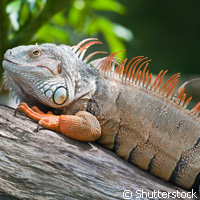Stomach disease in reptiles not due to greedy gulping
Snakes and reptiles are often heralded for their ability to gulp down their meals in one fell swoop, and although you might think this would play havoc with their digestion, new European research shows that it is in fact a parasitic infection that causes indigestion in snakes and lizards - rather than bad chewing habits. The findings, made by a team of researchers from the University of Veterinary Medicine in Vienna, Austria, show that it is the well-known gastrointestinal disease cryptosporidiosis that can pose severe problems for reptiles. The highly-contagious condition, which is not particularly prevalent among mammals, is very common among reptiles and can often be fatal. Scientists hope that by developing a means of early diagnosis they can curb spread of the disease. Writing in the Journal of Veterinary Diagnostic Investigation, the team members explain how they attempted to overcome the diagnostic difficulties surrounding the condition by developing a test to identify the single-cell parasite cryptosporidia that causes onset of the disease. This enabled them to assess its prevalence in pet lizards and snakes. Cryptosporidiosis has been known to scientists for over a century, but it was not until it was discovered to affect humans that perception of the disease shifted from one which was extremely rare to one that is more common. Also, it is often the case that the disease causing single-cell parasite cryptosporidia can cause gastrointestinal disease after a lengthy incubation period and until now no cure has been found. Diagnosis is conducted by detecting parasites in faeces. However, in snakes for example, this process is somewhat complicated by the fact that they excrete parasites that they swallow together with their prey. This means that the presence of cryptosporidia in faeces does not necessarily mean the animals are infected. In light of this, it is essential that scientists can distinguish between cryptosporidia that are connected to their prey and the infection-causing kind. This is where the DNA-procedure comes in as it can determine both whether cryptosporidia are present and whether they are of mammalian or snake origin. The team also identified another way in which the DNA-procedure can be problematic. 'A further problem is that cryptosporidia are often present in faeces in very low numbers so it is easy to miss them in a single test,' lead author Barbara Richter comments. 'We are working to make our method more sensitive but it is very important to test the reptiles repeatedly. A negative result does not necessarily mean that the animal is really free of the parasite.' The team's results show that a particular type of cryptosporidium was present in about one in six samples from the popular pet corn snake. Cryptosporidium was present in approximately 1 in 12 samples from the leopard gecko, a type of lizard frequently found in reptile collections. The team members were surprised by the results as they illustrate how widespread the disease has become. The fact that reptiles found in collections are susceptible to the disease is also worrying as, due to collections housing a large number of different species together, there is a high risk of cross-species infection.For more information, please visit:University of Veterinary Medicine Vienna:http://www.vu-wien.ac.at/en/
Countries
Austria



